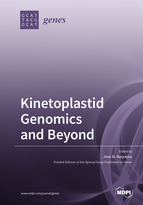Kinetoplastid Genomics and Beyond
A special issue of Genes (ISSN 2073-4425). This special issue belongs to the section "Microbial Genetics and Genomics".
Deadline for manuscript submissions: closed (10 September 2020) | Viewed by 39500
Special Issue Editor
Interests: Leishmania; Trypanosoma; heat shock proteins; RNA binding proteins; regulation of gene expression; genomics; transcriptomics
Special Issues, Collections and Topics in MDPI journals
Special Issue Information
Dear Colleagues,
For a long time, kinetoplastid protists (class Kinetoplastea) have attracted a great deal of scientific attention because this group includes several organisms of tremendous medical and economic importance (e.g., Trypanosoma ssp., causing Chagas disease and sleeping sickness in humans; and Leishmania spp., causing kala-azar and other leishmaniases). Moreover, many parasites for plants (Phytomonas spp.) and insects (Leptomonas, Crithidia, and other genera) also belong to this class. In addition, free-living kinetoplastids are abundant and active microbial predators in terrestrial and aquatic ecosystems.
On the other hand, these organisms are also the objects of considerable basic scientific interest due to their bizarre cytology, genome organization, and mechanisms of gene regulation. In recent years, the incorporation of “omics” methodologies to the study of these organisms has allowed assembly of the genomes for a growing number of both parasitic and free-living kinetoplastids to analyze changes in gene expression, determine the proteome compendium, establish metabolic pathways, and so on.
The aim of this Special Issue is to bring together a set of reviews and research articles addressing aspects like genome organization, mechanisms of gene expression, specific metabolic pathways, evolutionary relationships and databases, among others, focused on any species belonging to this group of protists.
Dr. Jose M. Requena
Guest Editor
Manuscript Submission Information
Manuscripts should be submitted online at www.mdpi.com by registering and logging in to this website. Once you are registered, click here to go to the submission form. Manuscripts can be submitted until the deadline. All submissions that pass pre-check are peer-reviewed. Accepted papers will be published continuously in the journal (as soon as accepted) and will be listed together on the special issue website. Research articles, review articles as well as short communications are invited. For planned papers, a title and short abstract (about 100 words) can be sent to the Editorial Office for announcement on this website.
Submitted manuscripts should not have been published previously, nor be under consideration for publication elsewhere (except conference proceedings papers). All manuscripts are thoroughly refereed through a single-blind peer-review process. A guide for authors and other relevant information for submission of manuscripts is available on the Instructions for Authors page. Genes is an international peer-reviewed open access monthly journal published by MDPI.
Please visit the Instructions for Authors page before submitting a manuscript. The Article Processing Charge (APC) for publication in this open access journal is 2600 CHF (Swiss Francs). Submitted papers should be well formatted and use good English. Authors may use MDPI's English editing service prior to publication or during author revisions.
Keywords
- kinetoplastids
- genome assembly and annotation
- regulation and gene expression
- proteome
- metabolomics
- phylogenetics
- databases







